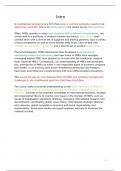Samenvatting
Summary SSMNE
- Instelling
- Universiteit Antwerpen (UA)
Vak: Strategy, structure and management of the multinational enterprise Docent: Sascha Albers In mijn persoonlijke samenvatting vind je al de te kennen theorie terug, inclusief verdere verduidelijking en voorbeelden. Daarnaast zorgt het gebruik van kleur ervoor dat het makkelijker studeerbaar i...
[Meer zien]



